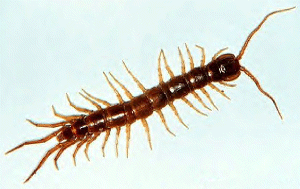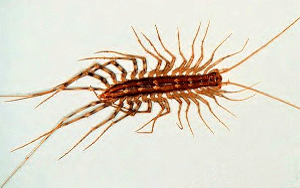
Consulting Entomologist

Tel/Fax: 01275 854224
E-Mail: [email protected]
Site Guide
Site Search
Home Page
Career Page
Insect Files
- Contents
- Bug Index
- The World of Bugs
- Classification of Bugs
- Insect Identification
- Insect Fossils
- Insect Body-parts
- Micro View of Bugs
- Insect Life Cycles
- Insect Defences
- Insects of Nailsea
- Pesticide Safety
- Bibliography
Shortcut to the main groups of insects and other arthropods...
Bug Rhymes & Poems
Links
Shop
Payments (credit/debit card)
Centipedes or Scolopenders |
Class: Myriapoda Order: Chilopoda |
| Centi-pede means 'hundred-footed', though most have fewer 'feet' (or legs) . . . . . . | |
|
Among the poisonous and most feared arthropods are the centipedes or scolopenders (Chilopoda). Their narrow extended body is made up of anything between 15 to 150 or more segments, depending on the species and individual, with each segment bearing a pair of legs. The head carries a pair of long, sensitive antennae and, in addition to small chewing mouthparts, a pair of large, strong claw-like structures which close together like tongs just below the head and are equiped with poison glands. Centipedes are carnivorous and use their poisonous head-claws to seize and paralyse their prey. They hunt, mostly at night, for arthropods and other invertebrates such as insects, spiders and worms, although some of the very large tropical species (the so called Giant Centipedes, in some cases up to 25 cm long) also attack small vertebrates. Many of the larger centipedes have an unpleasant bite and the poison of some giant species can be dangerous to humans, especially children. |
|
|
|
The centipede most often seen in northern Europe and the British Isles is the Brown Centipede, Lithobius forficatus, which grows up to 3 cm long and has 15 pairs of legs. It is glossy brown in colour and hides during the day under stones, leaf litter, loose bark and other such places. It occurs in both urban and rural areas, and frequently finds shelter inside garden sheds, houses and other buildings, especially among items stored in dark, damp places where there is little disturbance. Full-grown specimens can bite humans, but generally they will only do so if accidentally squeezed or handled without care. In most cases the bite has little or no after-effects. |
|
Other fairly common European species include the pale red or yellowish Snake or Garden Centipedes, Geophilus and Haplophilus, which have very narrow, elongated bodies up to 7 cm long, with around 40-80 pairs of relatively short legs. They are found in soil and leaf litter, and quite often exposed when turning-over garden soil. They wriggle violently like a snake when disturbed, but are quite harmless. |
|
|
|
In some parts of the world there are centipedes, e.g., Scutigera, which habitually live inside houses and other buildings, usually in slightly damp places such as cellars and basements. These so called House Centipedes, which generally grow to about 3 cm long, differ from other centipedes in having very long, delicate legs (usually 15 pairs) with the hind pair extremely long and thin. They also have very long antennae and compound eyes (typical centipedes have a clump of simple eyes on each side of the head). In warm climates they can survive outside, living in caves and rocky places. They are very fast runners and prey on flies, cockroaches and other insects. House Centipedes can inflict a slightly painful bite, although they rarely seem to bite humans. |
|
Despite the poisonous bite of some species, centipedes on the whole can be regarded as largely beneficial, particularly around the garden and in farm crops where they often prey on root-feeding insect grubs. Even the odd one or two centipedes living indoors might be tolerated considering their potential value in keeping at bay cockroaches and other unwelcome domestic insect pests. Centipedes are sometimes confused with their many-legged relatives the millipedes (Diplopoda), but millipedes have two pairs of legs on most body segments instead of the single pair of centipedes. Millipedes are also rather slow-moving creatures that feed on plant matter, compared with the fast running, carnivorous centipedes. | |
|
|
|
RELATED PAGES (Other Myriapoda) | |
|
PAUROPODS & SYMPHYLIDS (Pauropoda & Symphyla) |
MILLIPEDES (Diplopoda) |
 (classification of myriapods) |
| <<< TOP | (use the back button on your web browser to return to the previous page) | TOP >>> |

